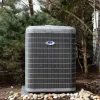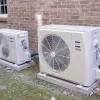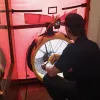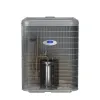Imagine it’s a cold morning. You’ve got your coffee and you’re wearing a sweater. You’re curled up in your favorite chair with a new book, and you’re looking forward to a little “cozy time” all to yourself.
But suddenly, there’s a whoosh of cold air.
It’s coming from a nearby window. The window is closed, but the cold air from that draft is making it hard to enjoy your coffee and your book.
Come to think of it, all of your windows have this problem. You start wondering if maybe all that cold air getting into the house is making your furnace work harder, costing you money, and sacrificing your comfort all through the winter.
Cold window drafts do cost you money.
They’re super uncomfortable, too.
The good news is that there is something you can do about them. The bigger question, however, is whether sealing off the drafts is the best way to save energy and feel more comfortable in your home.
First, let’s look at some ways to stop those drafts. Then we’ll go over what’s the best way to keep your house sealed off from cold air infiltration (and, for that matter, all sorts of air infiltration).
Got drafts? Caulk and weatherstripping are your friends.
That’s the simplest way to get rid of them. By applying caulk around the windows and/or installing weatherstripping in the offending areas, you block the drafts and solve the immediate problem. You can do the same thing for exterior doors.
However, if you’re concerned about energy loss around windows and doors, another good option is to remove the molding and spray canned foam around the frames. In most homes, builders just pack fiberglass into these areas. The fiberglass might provide a little thermal insulation, but it doesn’t do anything to stop the air leaks around the offending door or window.
The canned foam you get from the hardware store provides an air barrier and thermal insulation. If you get the type labeled “windows and doors,” the foam will expand into the gap but not enough to warp the door or window framing.
These DIY fixes are nice, but…
They usually solve a small problem and ignore a really big one.
The reason many people are so keen to stop cold window drafts is that those are the drafts they notice. We sit next to the windows. We stand beside doors. When there’s a draft coming from one or another, we can feel it.
But it’s the drafts we can’t feel that are almost always the biggest offenders.
Well, we do feel them. Just not directly.
The biggest drafts usually come from your attic or crawlspace.
You don’t notice these as much because you don’t hang out around them.
In a typical home, there are lots of wires, pipes, and ducts that run from the living space to the attic or crawlspace (or the basement, if you’ve got one). By and large, these are out of sight and out of mind. Wires live behind walls; ditto for most pipes and ducts, although you can access some of your plumbing beneath sinks.
All of these electrical, plumbing and HVAC penetrations are rarely sealed off. In many cases, there are very large gaps around the pipes, ducts, and wires. Unconditioned, unfiltered air is entering your home from these spaces all the time. Most people just don’t realize it because they don’t feel the drafts directly.
And it’s not just because there are so many of these drafts.
It’s because of where they are.
Because of the stack effect in buildings, air tends to move through structures vertically, not horizontally. In short, a much larger volume of air is moving through those attic and crawlspace penetrations than the little gaps around your living room windows.
Now consider that in addition to a larger volume of air, there are also — and this is usually the case — larger and more numerous gaps and cracks at the top and bottom of your home. It becomes pretty clear, pretty quickly that those window and door drafts are not your biggest air infiltration problem!
If you want to reduce drafts, stop air infiltration, lower your energy bills, and feel more comfortable in your home all year round, you should focus on sealing your attic and crawlspace penetrations. More often than not, the effect will be much greater than caulking and weatherstripping your windows.
Wondering which cold drafts to prioritize?
Every home is different. Most homes experience significant air infiltration at the top and bottom of the envelope, but that doesn’t mean uncaulked windows and doors aren’t also a big source of energy loss.
The best way to prioritize your air sealing efforts is to have a home performance professional perform a blower door and thermal imaging test.
- The blower door uses a big fan to depressurize your home. Air will be consistently passing through the biggest gaps and cracks during the test.
- During the blower door test, your contractor will scour your home with a thermal imaging camera. This camera reveals the areas where air infiltration contributes to significant heat loss. The images reveal which areas are the biggest offenders (i.e., the biggest sources of infiltration) and which gaps and cracks are less problematic.
Ultimately, the results of this process can help you identify which problems to solve first, maximizing the impact of your energy efficiency improvements.
So, yes. You should seal off those window drafts.
Just remember that your biggest drafts are probably somewhere else!
If you live in Metro Atlanta and have questions about home performance, energy efficiency improvements, or air sealing, give us a shout! We’ll listen to your concerns and help you figure out the right course of action for improving comfort and lowering your energy bills.
Get in touch today to schedule an appointment!






